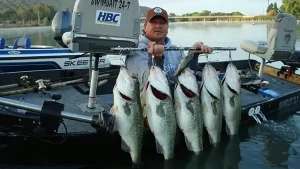With the rise of artificial intelligence and its widespread application in social media and digital publishing, many may view these advancements as the primary challenge in today’s fishing world. However, the real issue in fishing circles isn’t technology itself, but the way social media has affected the sport. While tournament bass fishing often draws attention to the negativity from anglers and fans, these concerns pale in comparison to the broader impact of social media, particularly in how it has compromised some of the best fishing spots.
Sharing big catches and fishing adventures on social media can be enjoyable, but the downsides, especially in relation to certain fisheries, are becoming more evident.
Impact on Fishery Management
One of the most notable effects social media has had on fisheries can be seen at Grenada Lake, often considered a crappie fishing paradise. The Mississippi Department of Fisheries Wildlife and Parks recently had to revise the creel limits on the four flood control lakes known for crappie fishing—Grenada, Sardis, Enid, and Arkabutla. The limits were reduced from 15 fish per person to 10, and the boat limit dropped from 40 fish per day to 25.
Many have attributed the increased catches to advancements in forward-facing sonar, but the real culprit was the influx of anglers driven by social media posts showcasing giant crappies. Thousands of posts showing off impressive hauls created a surge in fishing activity, with anglers flocking from all over the country. This surge was fueled further by the media, leading to overfishing in these once plentiful spots.
Local anglers from Kentucky Lake, for instance, were making regular trips to Grenada, coming back with significant catches of crappie each weekend. These lakes have long been known as prime spots for catching big crappies, and the combination of word-of-mouth and social media exacerbated the pressure on these waters.
As creel limits have tightened, many anglers now question whether the trip is worth it. With fewer people traveling to these lakes, it is anticipated that the fisheries will eventually rebound, improving the overall health of these crappie populations.
Swimbait Anglers and Secrecy
The rise of social media has also had an effect on bass fishing, particularly among swimbait enthusiasts. Anglers frequently post pictures of their impressive catches, but many go to great lengths to hide the location of their fishing spots. Using tactics like blurring backgrounds or editing out landmarks, these anglers aim to protect their favorite fisheries from becoming overrun.
Groups of avid swimbait anglers who consistently catch large bass, often over 10 pounds, have even made pacts to keep certain locations a secret. Rather than posting their successes online, they share photos privately with close friends. This approach helps prevent small, productive fisheries from becoming overwhelmed by the attention that comes with social media exposure.

Impact on Fishing Patterns
Popular fishing techniques can quickly lose their effectiveness once shared widely on social media. For example, on Kentucky Lake, anglers used the Whopper Plopper for two years before the pattern became widely known. Once everyone was throwing the lure, the bite diminished almost overnight. The effectiveness of a lure can disappear quickly when a large number of anglers begin using it, leading to conditioned fish that no longer respond as they once did.
This pattern is not unique to Kentucky Lake; many other fisheries experience the same problem. Once a successful method, such as deep crankbaiting, is exposed on social media, the fish rapidly become conditioned, and the bite fades within days or weeks.
Forward-Facing Sonar vs. Social Media
There is a misconception that forward-facing sonar, a popular fishing technology, is ruining fishing. However, many believe that sonar technology actually helps anglers discover new fishing spots that others overlook. Rather than following the crowds to popular spots, anglers can use sonar to find fish in less obvious areas, allowing for more independent exploration.
In contrast, social media often has the opposite effect. When anglers post about a hot bite on platforms like Instagram or Facebook, it attracts crowds of fishermen to that same location. This overwhelming influx of anglers diminishes the bite and reduces the quality of the fishing experience for everyone involved.
Protecting Fisheries from Social Media
To counteract the negative effects of social media on fishing, some anglers have adopted strategies to protect their spots. Posting pictures from locations unrelated to where the fish were caught is one common tactic, sending others on wild goose chases. Others choose to avoid posting on social media altogether, sharing their catches only with close friends to protect the fisheries they cherish.
While sharing tips and techniques with fellow anglers is part of the community spirit of fishing, it is important to strike a balance. Oversharing can lead to overcrowded spots and depleted fisheries. Instead, anglers are encouraged to explore new areas, be protective of their local waters, and resist the urge to seek validation through social media.
By being mindful of how much is shared online, it is possible to preserve the joy of fishing while maintaining the health and sustainability of favorite fishing spots.
Image/Source: Wired2Fish





